Experimental and Model Analysis of the Thermal and Electrical Phenomenon of Arc Faults on the Electrode Pole of Lithium-Ion Batteries
Abstract
1. Introduction
2. The Mechanism of Arc Generation in High-Voltage Lithium-Ion Battery Systems
3. Computational Model of Arc Generation and Results Analysis
3.1. Geometric Model and Assumption Conditions
- (1)
- The initiation process of the arc is not considered.
- (2)
- It is assumed that the solved arc plasma is in a state of equilibrium, satisfying the local thermodynamic equilibrium.
- (3)
- The plasma density, electrical conductivity, thermal conductivity, specific heat at constant pressure, and dynamic viscosity are dependent solely on the temperature.
- (4)
- The impact of the arc on the contact erosion and the sheath layer near the electrode is neglected.
- (5)
- The arc plasma is assumed to be a stable, non-rotational, and incompressible ideal fluid.
3.2. Control Equations
- (1)
- Equation for energy conservation:
- (2)
- Radial momentum conservation equation:
- (3)
- Axial momentum conservation equation:
- (4)
- Mass conservation equation:
- (5)
- Current continuity equation:
- (6)
- Maxwell’s equations:
- (7)
- Ohm’s law:
3.3. Boundary Conditions
3.4. Analysis of Simulation Results
4. Experimental Results and Analysis
4.1. Experimental Platform Setup
4.2. Experimental Plan Formulation
- 1.
- Circuit Connection
- 2.
- Parameter Settings
- (1)
- Circuit Parameters: Power supply voltage Udc, electronic load R;
- (2)
- Arc Generator Parameters: Stepper motor moving speed v (minimum moving speed of the arc generator), separation gap L;
- (3)
- Detection Equipment Parameters: The high-speed camera captures the evolution of the arc process at a frame rate of 1000 frames/s; the sampling frequency of the high-speed data acquisition system is 1 kHz, recording the real-time voltage, current, and temperature data; thermocouples are arranged 6 mm away from the arc initiation point (to avoid damage due to high temperatures at the arc center) and used to approximate the temperature of the arc acting on the battery core. Table 3 shows the initial operational settings for the experiment.
4.3. Experimental Results Analysis
4.3.1. Charging Conditions
4.3.2. Discharge Conditions
4.4. Model Verification
5. Conclusions
- (1)
- The COMSOL 6.0 software was used to build a model of battery arc, simulate the change in the arc voltage under different gaps, and found the law that the arc voltage increases linearly with the gap. Meanwhile, it was found that the maximum value of the electric field strength was located near the cathode when the arc fault occurred, the maximum value of the magnetic flux density mode was located at the tip of the copper electrode, and the maximum value of the temperature and the flow field velocity of the arc was located at the center of the electrode spacing.
- (2)
- Ensure that the charging current is unchanged, the arc voltage is about 15 V under different supply voltage conditions, and the arc voltage and charging current are linearly changing with the separation gap. Under the discharge current of 10 A, the arc voltage is about 18 V, and the arc voltage also changes linearly with the separation distance. However, compared with the charging condition, the arc fault under the discharging condition is more intense, and the slope of the arc voltage is increased; at the same time, the arc erosion area on the battery surface is increased. The effects of battery disasters caused by arc faults are manifested in case of breakdown and electrolyte leakage, and the main reason for these disasters is the effect of the high arc temperature.
- (3)
- By comparing and analyzing the simulation results with the experimental data, it was observed that the voltage error at both ends of the arc was less than ±0.14 V, and the temperature error was less than 3%. This validates the accuracy of the battery arc simulation model.
Author Contributions
Funding
Data Availability Statement
Acknowledgments
Conflicts of Interest
References
- Yu, W.H.; Guo, Y.; Shang, Z.; Zhang, Y.C.; Xu, S.M. A review on comprehensive recycling of spent power lithium-ion battery in China. eTransportation 2022, 11, 100155. (In English) [Google Scholar] [CrossRef]
- Li, Y.; Wei, Y.; Zhu, F.; Du, J.; Zhao, Z.; Ouyang, M. The path enabling storage of renewable energy toward carbon neutralization in China. eTransportation 2023, 16, 100226. [Google Scholar] [CrossRef]
- Zhou, W.; Liu, Z.; An, Y.; Luo, M.; Zhang, X.; Song, S.; Li, C.; Liu, Z.; Gao, Y.; Zhang, H.; et al. Thermal behavior analysis of lithium-ion capacitors at transient high discharge rates. J. Energy Storage 2022, 53, 105208. [Google Scholar] [CrossRef]
- Wassiliadis, N.; Steinsträter, M.; Schreiber, M.; Rosner, P.; Nicoletti, L.; Schmid, F.; Lienkamp, M. Quantifying the state of the art of electric powertrains in battery electric vehicles: Range, efficiency, and lifetime from component to system level of the Volkswagen ID.3. eTransportation 2022, 12, 100167. (In English) [Google Scholar] [CrossRef]
- Yin, H.; Ma, S.; Li, H.; Wen, G.; Santhanagopalan, S.; Zhang, C. Modeling strategy for progressive failure prediction in lithium-ion batteries under mechanical abuse. eTransportation 2021, 7, 100098. [Google Scholar] [CrossRef]
- Chen, Q.; Chen, X.; Li, Z. A fast numerical method with non-iterative source term for pseudo-two-dimension lithium-ion battery model. J. Power Sources 2023, 577, 233258. [Google Scholar] [CrossRef]
- Xu, W.Q.; Wu, X.G.; Li, Y.L.; Wang, H.W.; Lu, L.G.; Ouyang, M.G. A comprehensive review of DC arc faults and their mechanisms, detection, early warning strategies, and protection in battery systems. Renew. Sustain. Energy Rev. 2023, 186, 113674. (In English) [Google Scholar] [CrossRef]
- Zhou, W.; Liu, Z.; Chen, W.; Zhang, X.; Sun, X.; Luo, M.; Ma, Y. Thermal characteristics of pouch lithium–ion battery capacitors based on activated carbon and LiNi1/3Co1/3Mn1/3O2. J. Energy Storage 2023, 66, 107474. [Google Scholar] [CrossRef]
- Hastings, J.K.; Juds, M.A.; Luebke, C.J.; Pahl, B. A study of ignition time for materials exposed to DC arcing in PV systems. In Proceedings of the 2011 37th IEEE Photovoltaic Specialists Conference (PVSC 2011), Seattle, WA, USA, 19–24 June 2011; pp. 003724–003729. (In English). [Google Scholar]
- Zhang, Z.Y.; Nie, Y.M.; Lee, W.J. Arc Voltage Characteristics of Medium-Low Voltage Arc Fault in Short Gaps. In Proceedings of the 53rd Annual Meeting of the IEEE-Industry-Applications-Society (IAS), Portland, OR, USA, 23–27 September 2018; IEEE: Portland, OR, USA; New York, NY, USA, 2018. [Google Scholar]
- Li, Y.L.; Feng, X.N.; Ren, D.S.; Ouyang, M.G.; Lu, L.G.; Han, X.B. Thermal Runaway Triggered by Plated Lithium on the Anode after Fast Charging. Acs Appl. Mater. Interfaces 2019, 11, 46839–46850. (In English) [Google Scholar] [CrossRef]
- Xie, W.; Liu, X.; He, R.; Li, Y.; Gao, X.; Li, X.; Peng, Z.; Feng, S.; Feng, X.; Yang, S. Challenges and opportunities toward fast-charging of lithium-ion batteries. J. Energy Storage 2020, 32, 101837. (In English) [Google Scholar] [CrossRef]
- Zhou, W.; Liu, Z.; Chen, W.; Sun, X.; Luo, M.; Zhang, X.; Li, C.; An, Y.; Song, S.; Wang, K.; et al. A Review on Thermal Behaviors and Thermal Management Systems for Supercapacitors. Batteries 2023, 9, 128. (In English) [Google Scholar] [CrossRef]
- Abdullah, Y.; Shaffer, J.; Hu, B.; Hall, B.; Wang, J.G.; Emrani, A.; Arfaei, B. Hurst-Exponent-Based Detection of High-Impedance DC Arc Events for 48-V Systems in Vehicles. IEEE Trans. Power Electron. 2021, 36, 3803–3813. (In English) [Google Scholar] [CrossRef]
- Augeard, A.; Singo, T.; Desprez, P.; Abbaoui, M. Contribution to the Study of Electric Arcs in Lithium-Ion Batteries. IEEE Trans. Compon. Packag. Manuf. Technol. 2016, 6, 1068–1078. (In English) [Google Scholar] [CrossRef]
- Shigeta, M.; Tanaka, M. Visualization of electromagnetic-thermal-fluid phenomena in arc welding. Jpn. J. Appl. Phys. 2020, 59, Sa0805. (In English) [Google Scholar] [CrossRef]
- Chu, R.B.; Schweitzer, P.; Zhang, R.C. Series AC Arc Fault Detection Method Based on High-Frequency Coupling Sensor and Convolution Neural Network. Sensors 2020, 20, 4910. (In English) [Google Scholar] [CrossRef] [PubMed]
- Cui, R.; Wang, C.; Wang, Y. Application of VMD-ApEn in aviation AC series arc fault detection. Electr. Mach. Control. 2020, 24, 141–149. (In Chinese) [Google Scholar]
- Jalil, M.; Samet, H.; Ghanbari, T.; Tajdinian, M. Development of Nottingham Arc Model for DC Series Arc Modeling in Photovoltaic Panels. IEEE Trans. Ind. Electron. 2022, 69, 13647–13655. (In English) [Google Scholar] [CrossRef]
- Wang, Q.; Chen, S.; Meng, Y.; Yang, Q.; Li, X. Review of Research on DC Arc Fault Detection Technology in Low Voltage DC System. High Volt. Appar. 2023, 59, 93–103. (In Chinese) [Google Scholar]
- Marulanda-Durango, J.; Escobar-Mejía, A.; Alzate-Gómez, A.; Alvarez-López, M. A Support Vector machine-Based method for parameter estimation of an electric arc furnace model. Electr. Power Syst. Res. 2021, 196, 107228. (In English) [Google Scholar] [CrossRef]
- Aziz, F.; Haq, A.U.; Ahmad, S.; Mahmoud, Y.; Jalal, M.; Ali, U. A Novel Convolutional Neural Network-Based Approach for Fault Classification in Photovoltaic Arrays. IEEE Access 2020, 8, 41889–41904. (In English) [Google Scholar] [CrossRef]
- Huang, K.; Sun, H.; Niu, C.; Wu, Y.; Rong, M.; Yan, G.; Huang, G. Simulation of arcs for DC relay considering different impacts. Plasma Sci. Technol. 2020, 22, 024003. (In English) [Google Scholar] [CrossRef]
- Cao, Q.; Liu, X. Simulation Analysis and Experimental Research on Arc Motion in High Voltage DC Relay. Trans. China Electrotech. Soc. 2019, 34, 4699–4707. (In Chinese) [Google Scholar]
- Jiang, Y.; Li, Q.; Cui, J.; Wu, J.; Jia, B. Re-Ignition of Intermediate Frequency Vacuum Arc at Axial Magnetic Field. Trans. China Electrotech. Soc. 2020, 35, 3860–3868. (In Chinese) [Google Scholar]
- Wu, Q.R.; Yang, K.; Zhang, R.C.; Tu, R.; Zhou, X.J. Numerical study on instantaneous heat transfer characteristics of AC arc-fault. Aip Adv. 2021, 11, 095009. (In English) [Google Scholar] [CrossRef]
- Deng, Q.; Xu, P.; Zang, T.L. Simulation Analysis of DC Arc Extinguishing Characteristics of Arcing Horn. In Proceedings of the IEEE IAS Conference on Industrial and Commercial Power System Asia (IEEE I and CPS Asia), Chengdu, China, 18–21 July 2021; IEEE: New York, NY, USA; pp. 1150–1153. [Google Scholar]
- Huang, X.; Sun, T.; Wu, Y.; Yang, S.; Zhao, L.; Ning, W.; Wang, L. Study of vacuum arc plasma transport characteristics during the DC interrupting process. J. Phys. D-Appl. Phys. Artic. 2022, 55, 165501. (In English) [Google Scholar] [CrossRef]
- Hoerauf, R.; Shipp, D.D. Characteristics and applications of various arc interrupting methods. IEEE Trans. Ind. Appl. 1991, 27, 849–861. (In English) [Google Scholar] [CrossRef]
- Shkol’nik, S.M. Anode phenomena in arc discharges: A review. Plasma Sources Sci. Technol. 2011, 20, 013001. (In English) [Google Scholar] [CrossRef]
- Ammerman, R.F.; Gammon, T.; Sen, P.K.; Nelson, J.P. DC-Arc Models and Incident-Energy Calculations. Ieee Trans. Ind. Appl. 2010, 46, 1810–1819. (In English) [Google Scholar] [CrossRef]
- Miller, H.C. Plasma and Spot Phenomena in Electrical Arcs. IEEE Trans. Plasma Sci. 2021, 49, 4038. (In English) [Google Scholar] [CrossRef]
- Wang, C.; Lu, Z.S.; Li, D.N.; Xia, W.L.; Xia, W.D. Effect of the Magnetic Field on the Magnetically Stabilized Gliding Arc Discharge and Its Application in the Preparation of Carbon Black Nanoparticles. Plasma Chem. Plasma Process. 2018, 38, 1223–1238. (In English) [Google Scholar] [CrossRef]
- Rong, M.; Li, M.; Wu, Y.; Yang, F.; Wu, Y.; Liu, W.; Li, Y.; Chen, Z. 3-D MHD Modeling of Internal Fault Arc in a Closed Container. IEEE Trans. Power Deliv. 2017, 32, 1220–1227. (In English) [Google Scholar] [CrossRef]


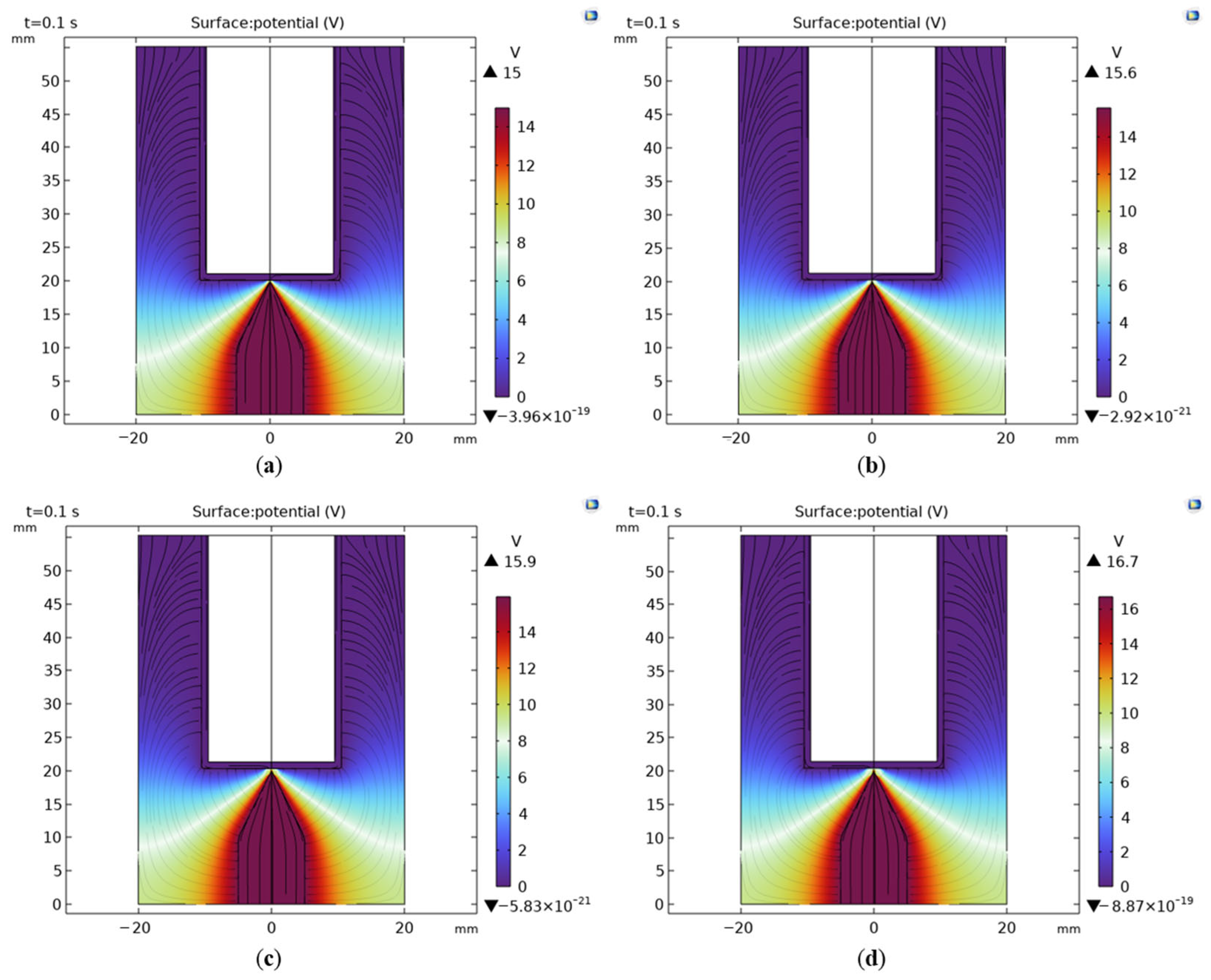
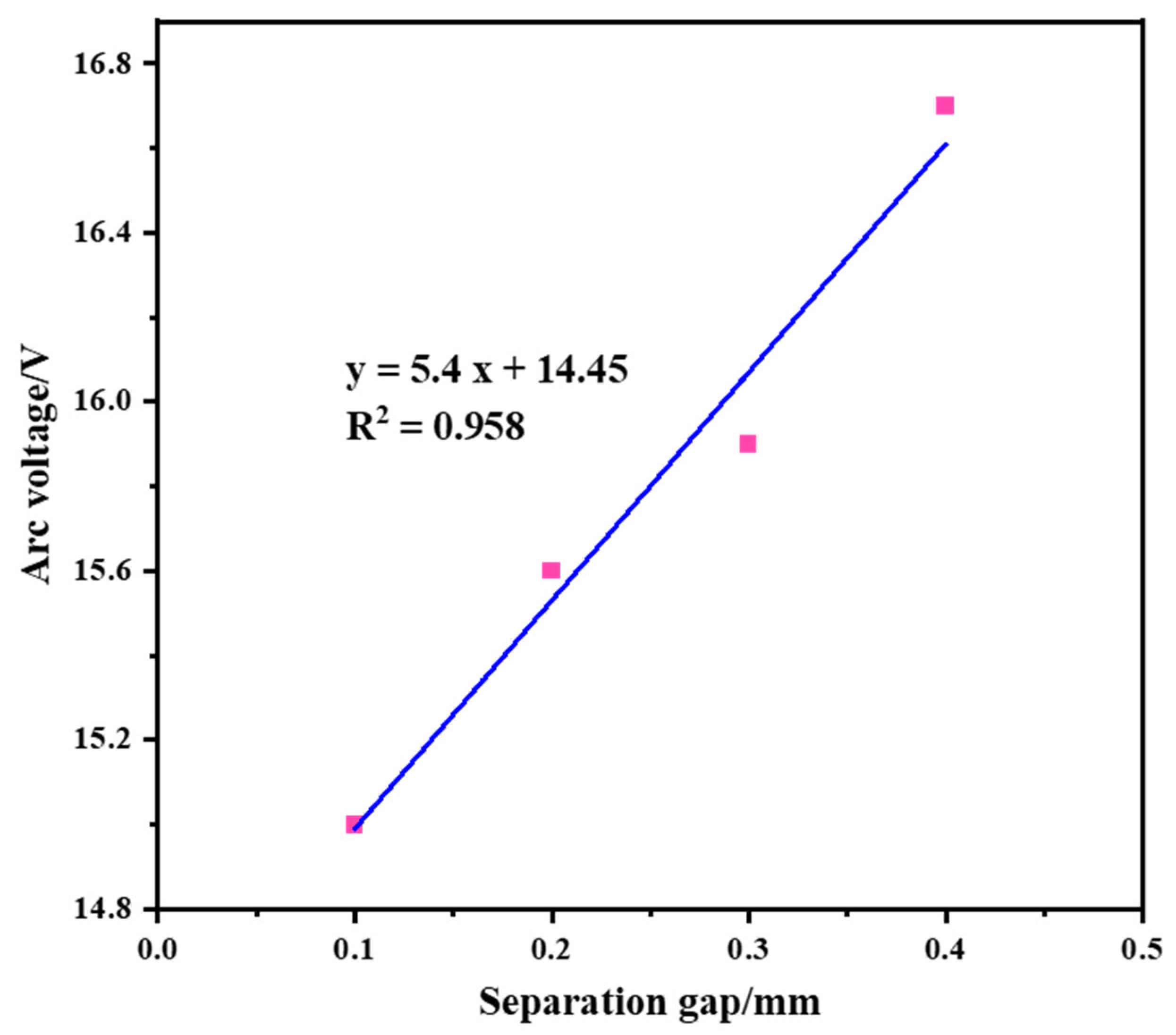
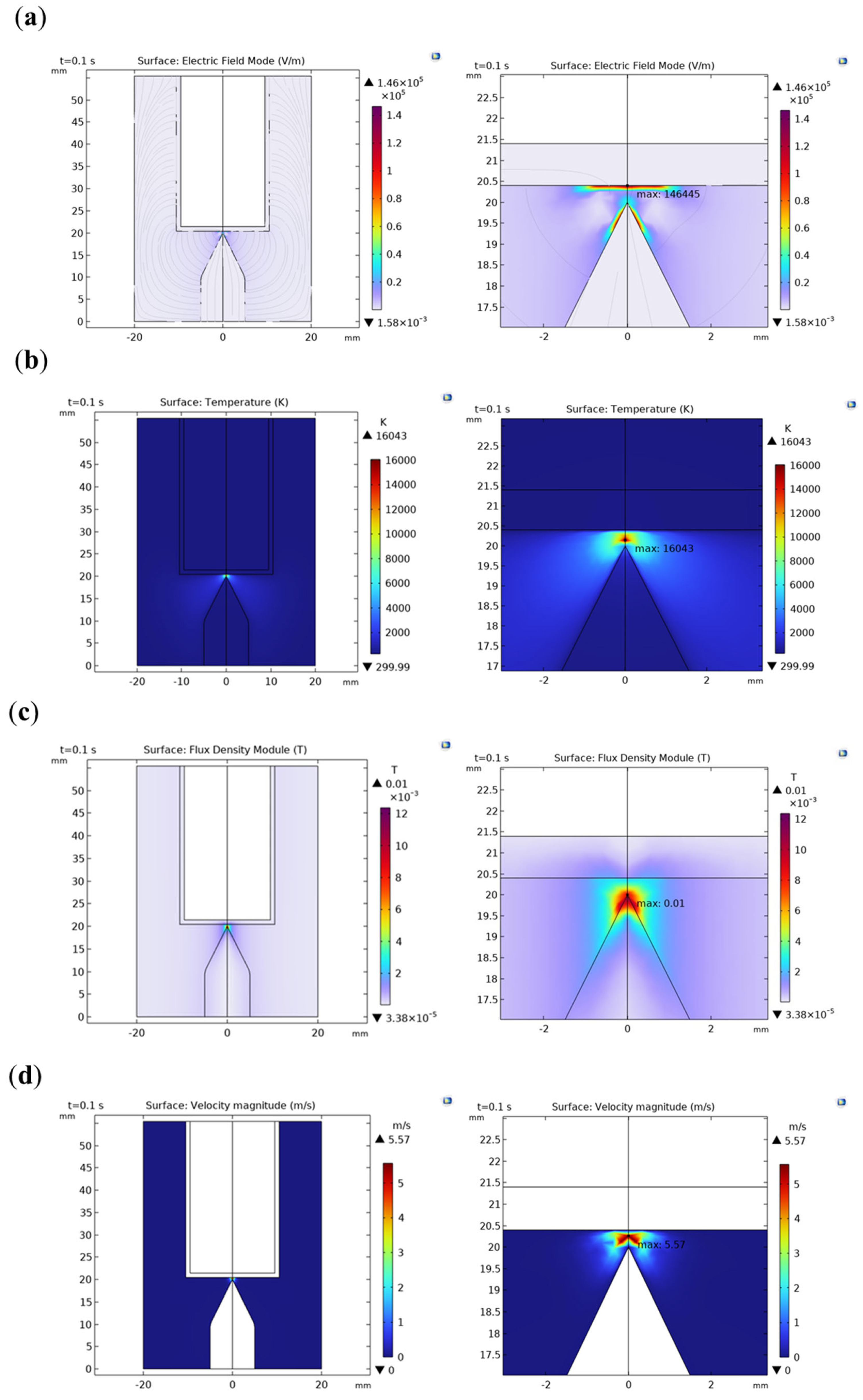

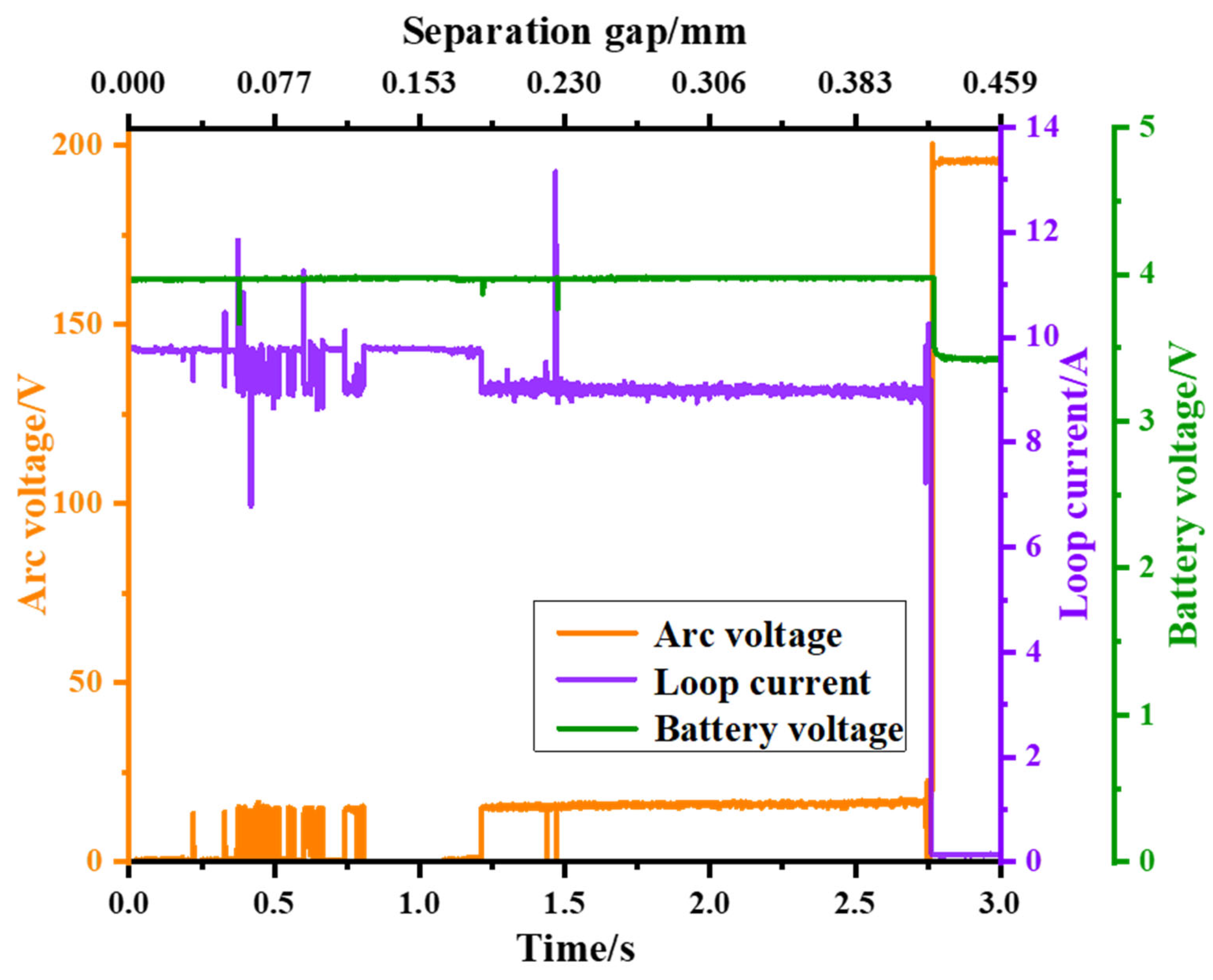
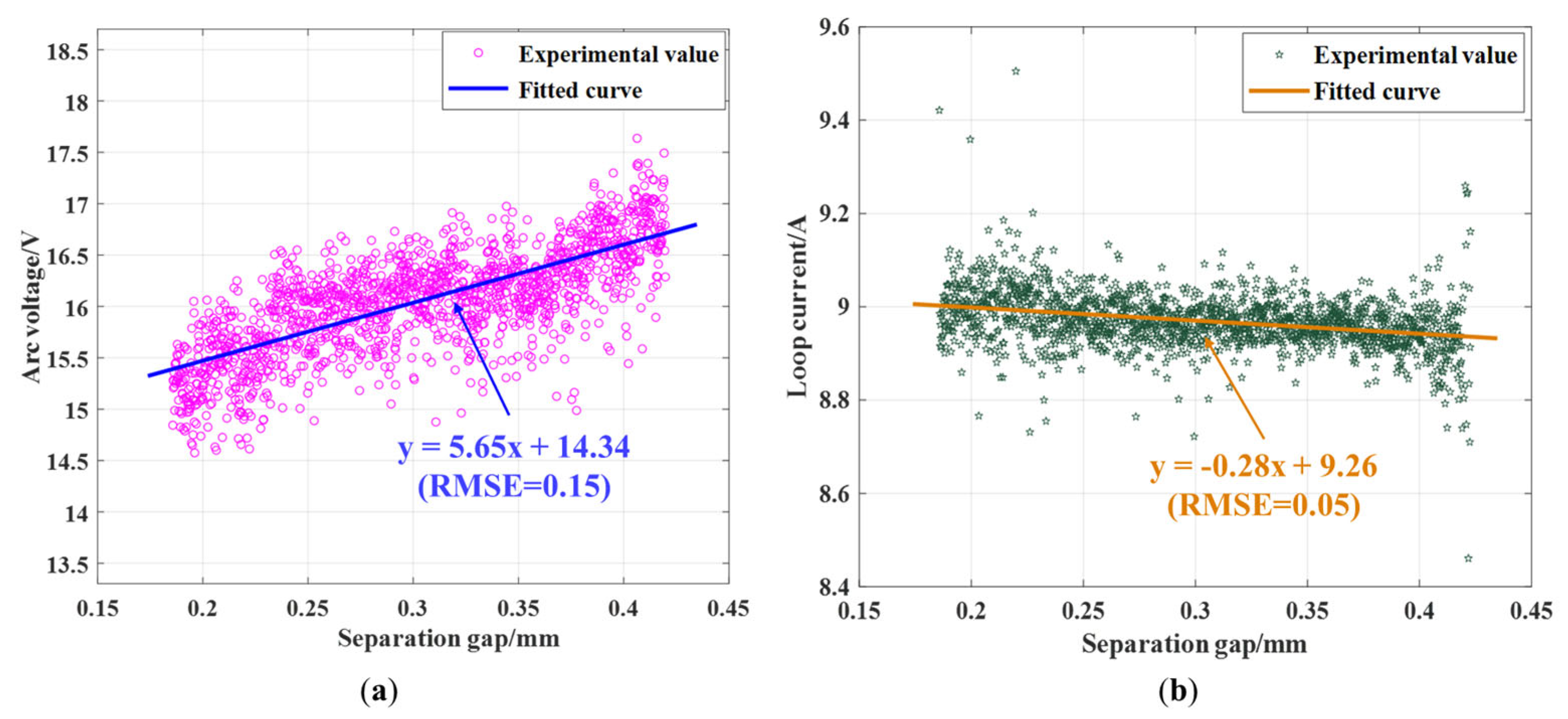
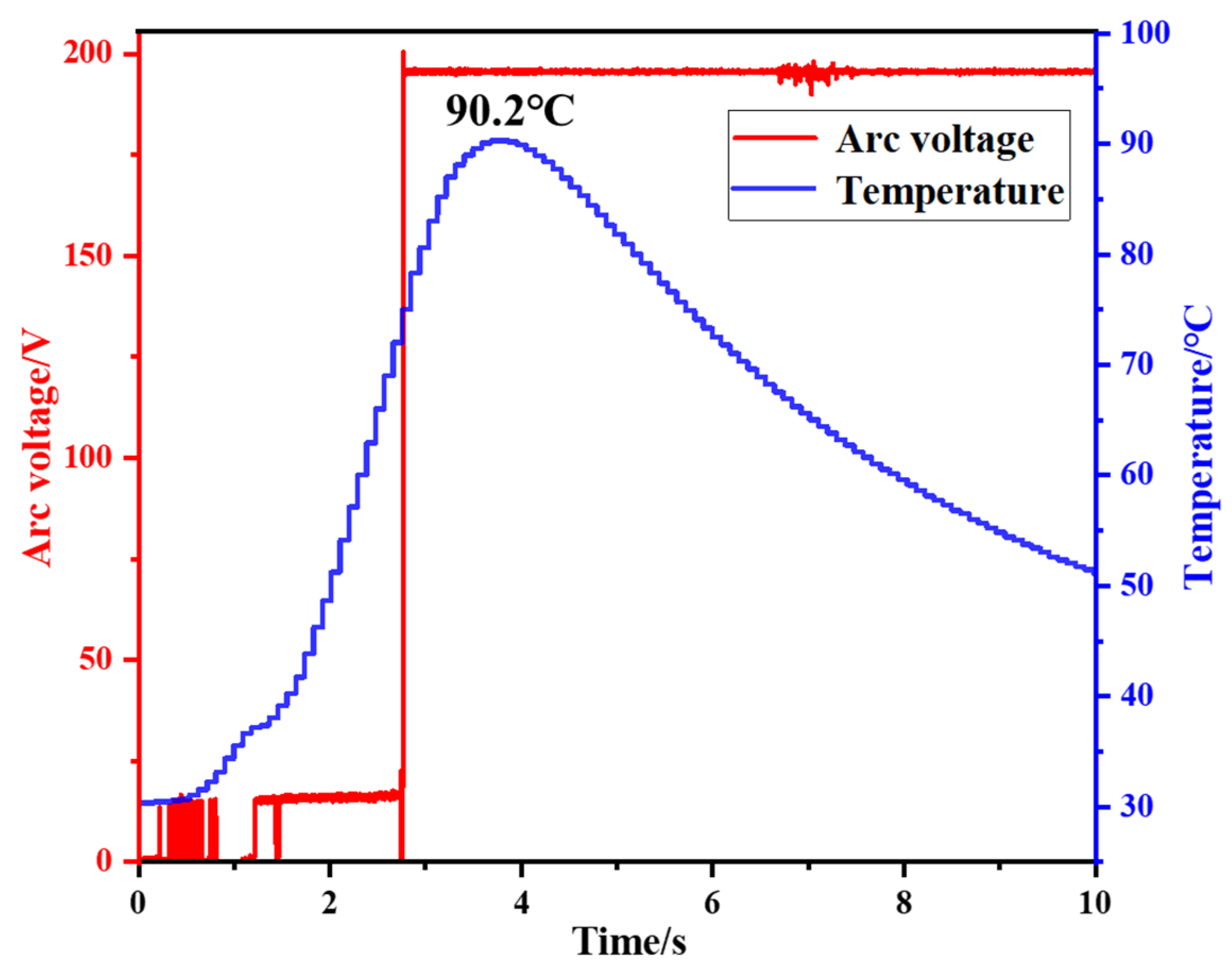

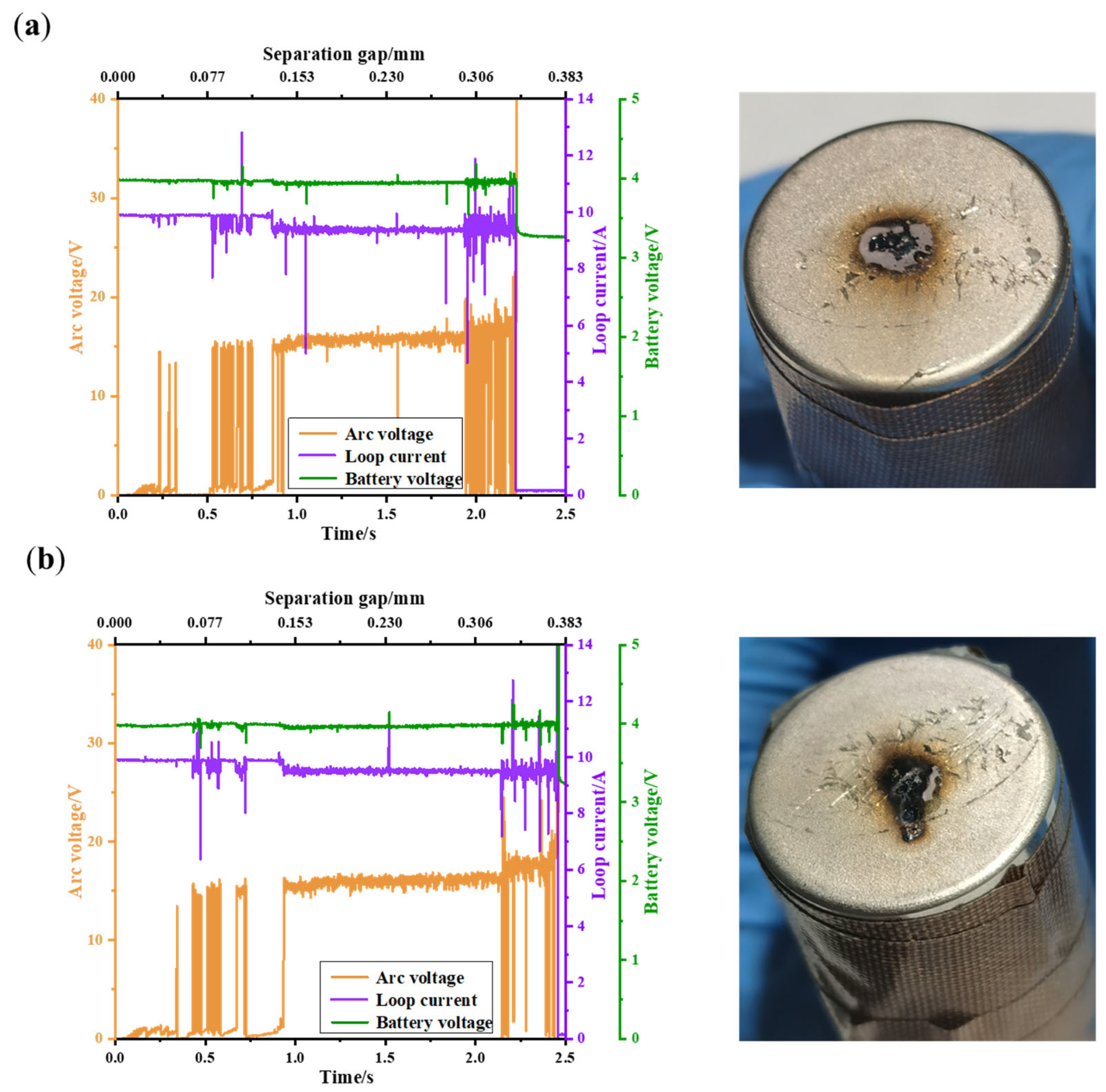
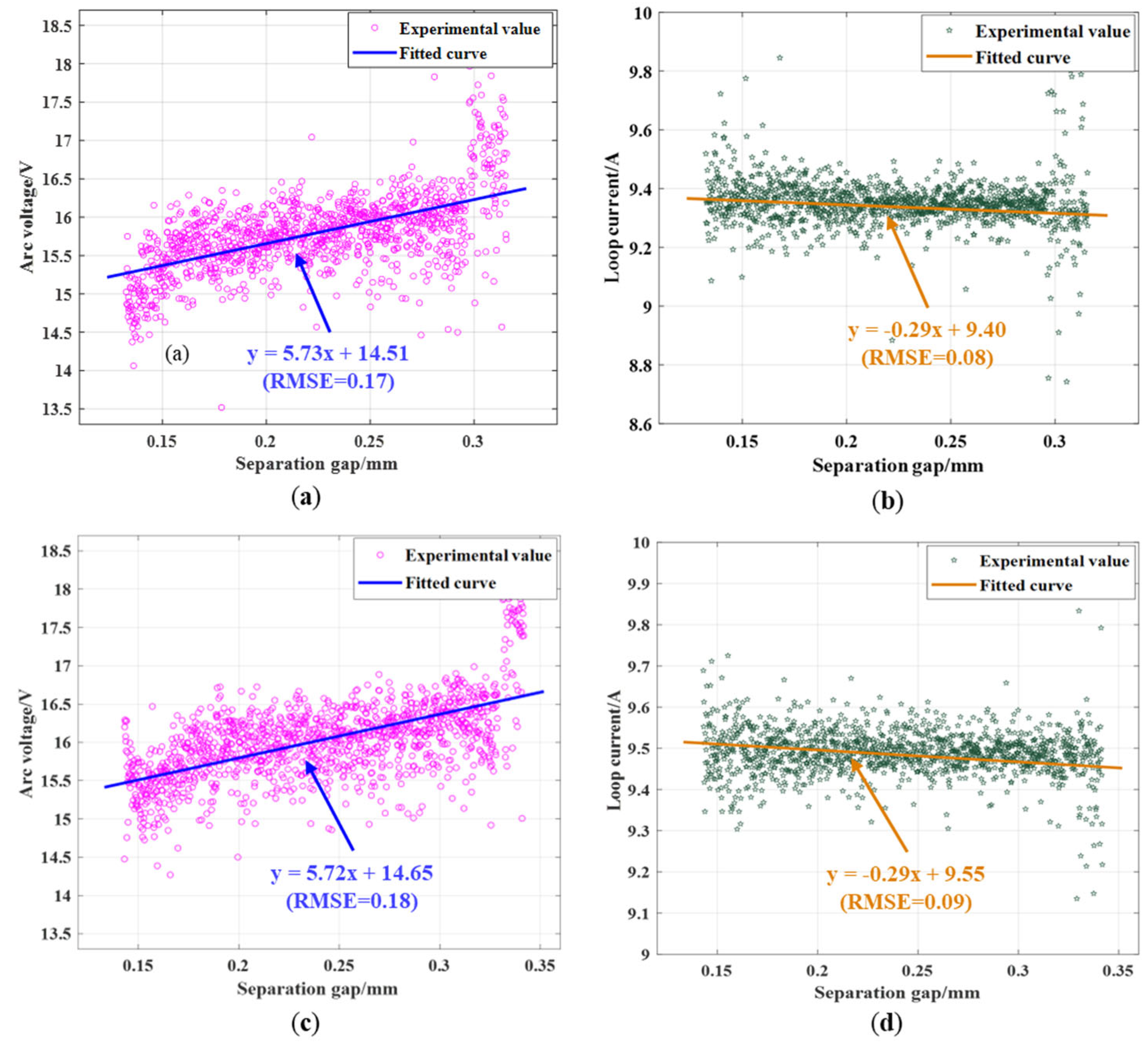


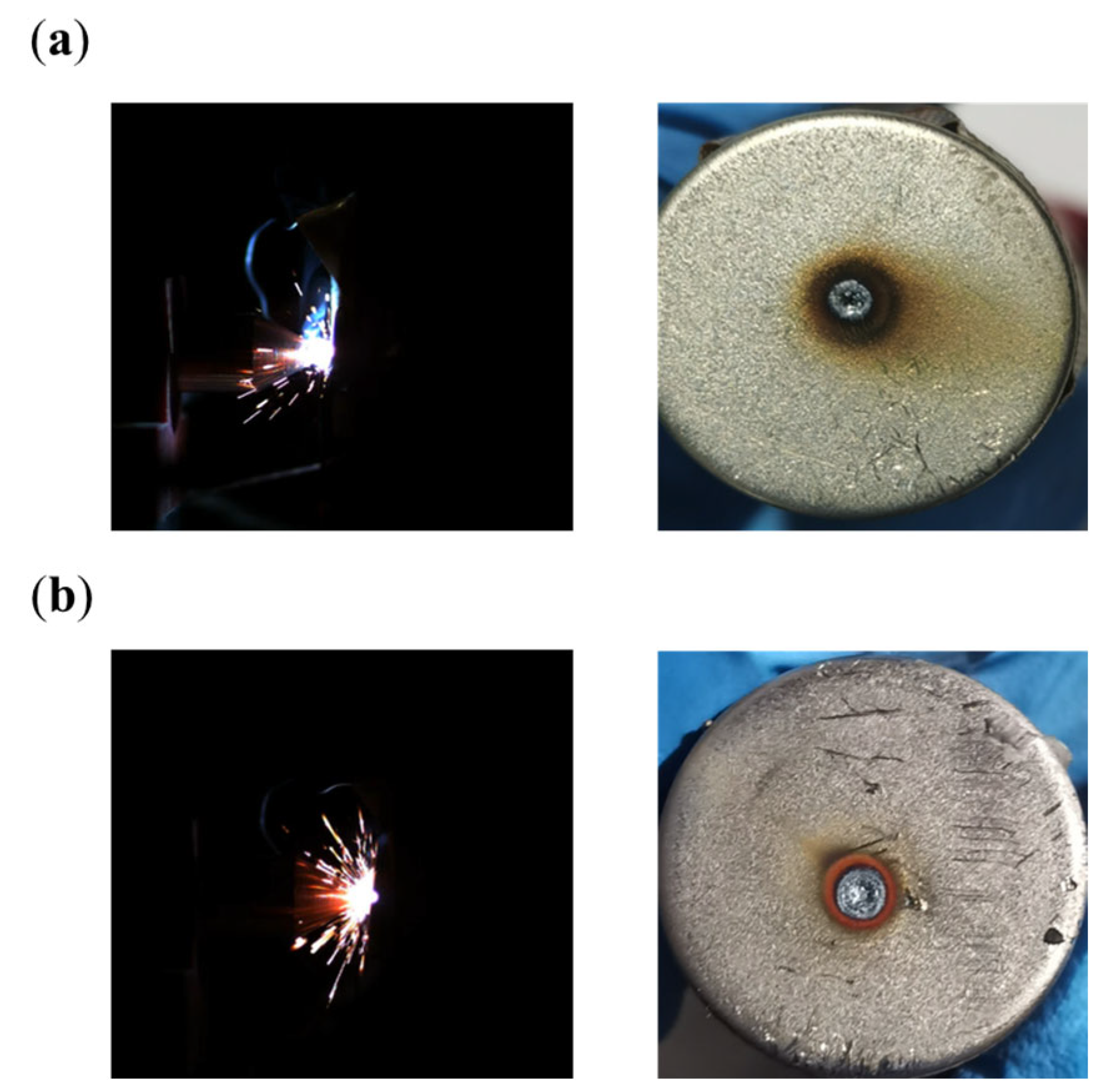
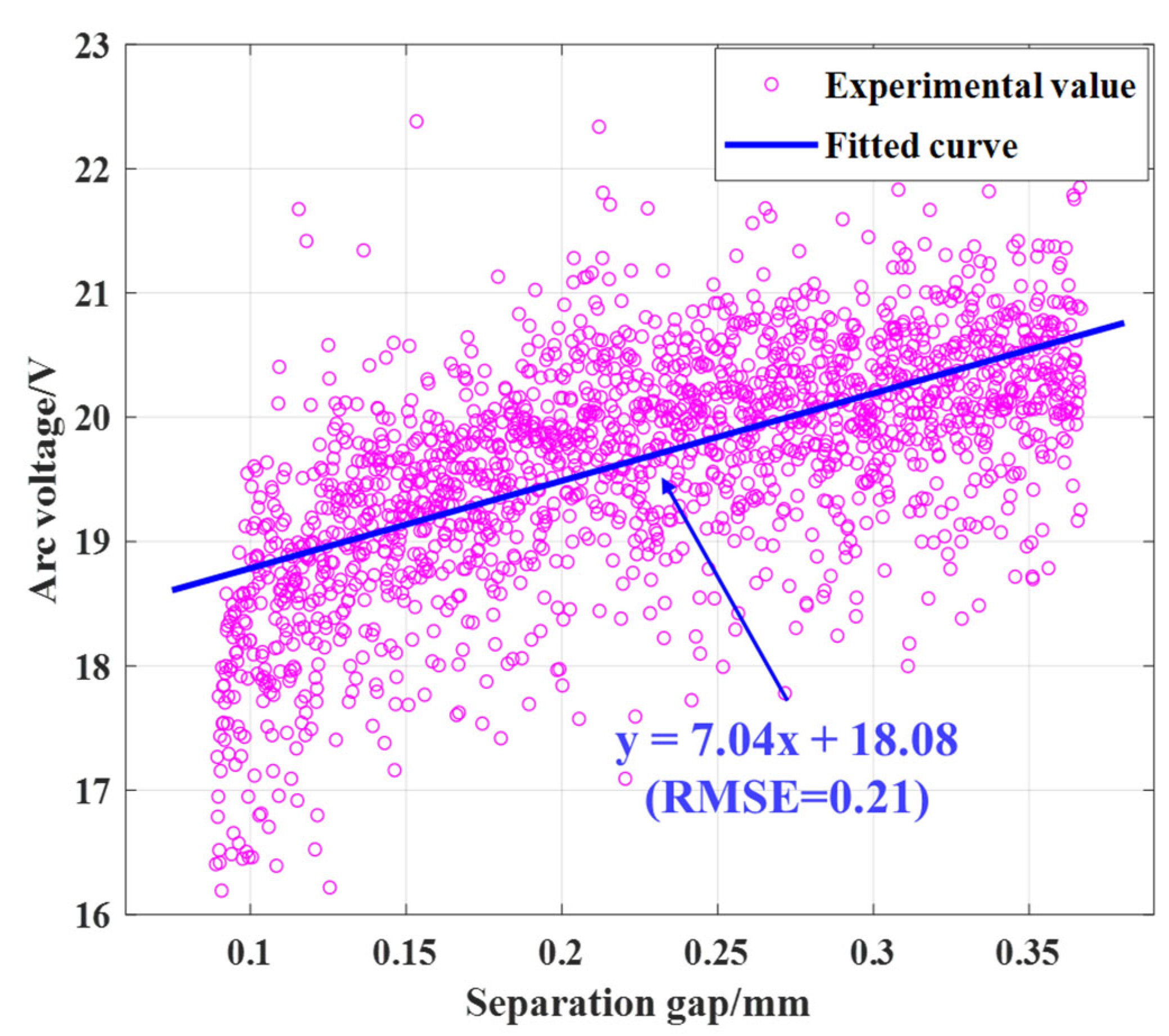
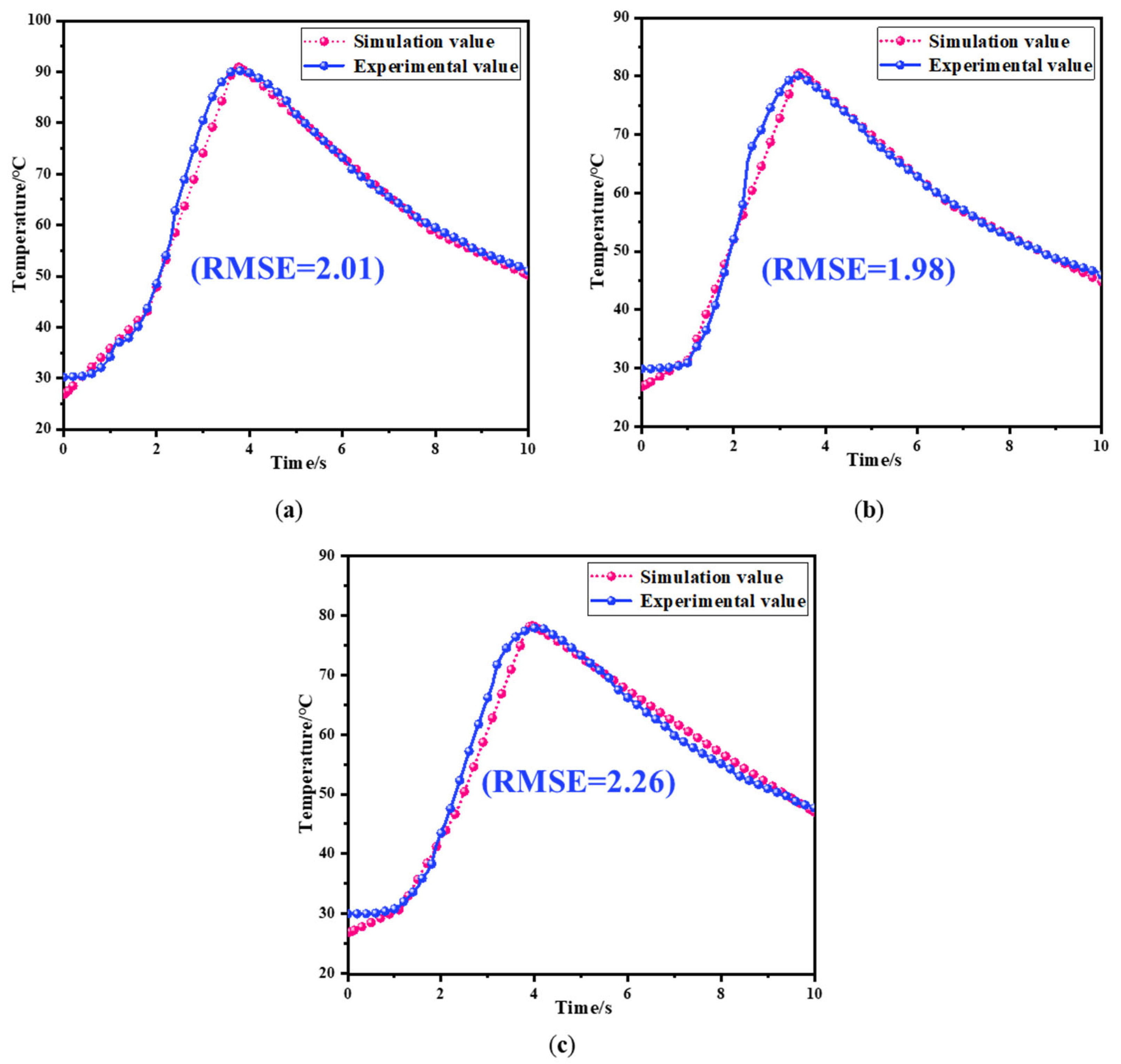
| Parameters | Numerical Values |
|---|---|
| Copper density/(kg/m3) | 8940 |
| Copper thermal conductivity/[W/(m·K)] | 400 |
| Copper constant pressure heat capacity/[J/(kg·K)] | 385 |
| Copper conductivity/[S/m] | 5.998 × 107 |
| Steel density/(kg/m3) | 7850 |
| Thermal conductivity of steel/[W/(m·K)] | 44.5 |
| Steel constant pressure heat capacity/[J/(kg·K)] | 475 |
| Steel conductivity/(S/m) | 4.032 × 106 |
| Initial air temperature/K | 300 |
| Initial ambient pressure/Pa | 1.01 × 105 |
| Equipment | Parameters |
|---|---|
| Brand | 21,700 |
| Positive electrode material | Ternary |
| Capacity (Ah) | 4.8 |
| Dimensions (mm) | 21 × 70 |
| Internal resistance of the battery (mΩ) | 45.6 mΩ |
| Top cover | Copper |
| Casing | Steel |
| Parameters | Preset Values |
| Arc generation location | The center of negative terminal on the battery casing |
| Power supply voltage Udc (V) | 200, 300, 400 |
| Electronic load R (Ω) | 20–40 Ω |
| Moving speed v (mm/s) | 0.153 |
| Separation gap L (mm) | 0.5 |
| Electrode separation time t (s) | 3.3 |
| High-speed camera frame rate (frames/s) | 1000 |
| High-speed data sampling frequency (KS/s) | 1 |
Disclaimer/Publisher’s Note: The statements, opinions and data contained in all publications are solely those of the individual author(s) and contributor(s) and not of MDPI and/or the editor(s). MDPI and/or the editor(s) disclaim responsibility for any injury to people or property resulting from any ideas, methods, instructions or products referred to in the content. |
© 2024 by the authors. Licensee MDPI, Basel, Switzerland. This article is an open access article distributed under the terms and conditions of the Creative Commons Attribution (CC BY) license (https://creativecommons.org/licenses/by/4.0/).
Share and Cite
Dong, C.; Gao, B.; Li, Y.; Wu, X. Experimental and Model Analysis of the Thermal and Electrical Phenomenon of Arc Faults on the Electrode Pole of Lithium-Ion Batteries. Batteries 2024, 10, 127. https://doi.org/10.3390/batteries10040127
Dong C, Gao B, Li Y, Wu X. Experimental and Model Analysis of the Thermal and Electrical Phenomenon of Arc Faults on the Electrode Pole of Lithium-Ion Batteries. Batteries. 2024; 10(4):127. https://doi.org/10.3390/batteries10040127
Chicago/Turabian StyleDong, Chuanyou, Bin Gao, Yalun Li, and Xiaogang Wu. 2024. "Experimental and Model Analysis of the Thermal and Electrical Phenomenon of Arc Faults on the Electrode Pole of Lithium-Ion Batteries" Batteries 10, no. 4: 127. https://doi.org/10.3390/batteries10040127
APA StyleDong, C., Gao, B., Li, Y., & Wu, X. (2024). Experimental and Model Analysis of the Thermal and Electrical Phenomenon of Arc Faults on the Electrode Pole of Lithium-Ion Batteries. Batteries, 10(4), 127. https://doi.org/10.3390/batteries10040127







